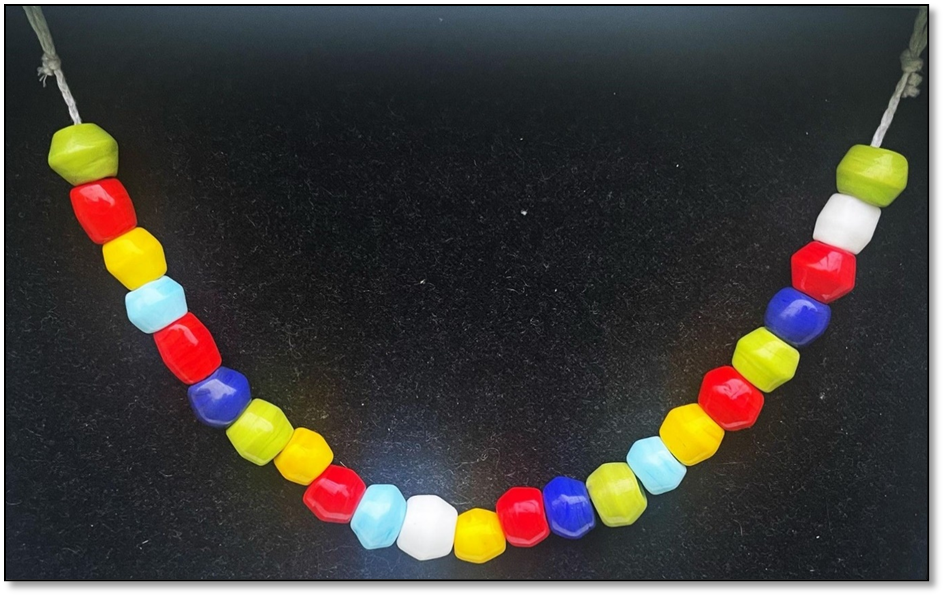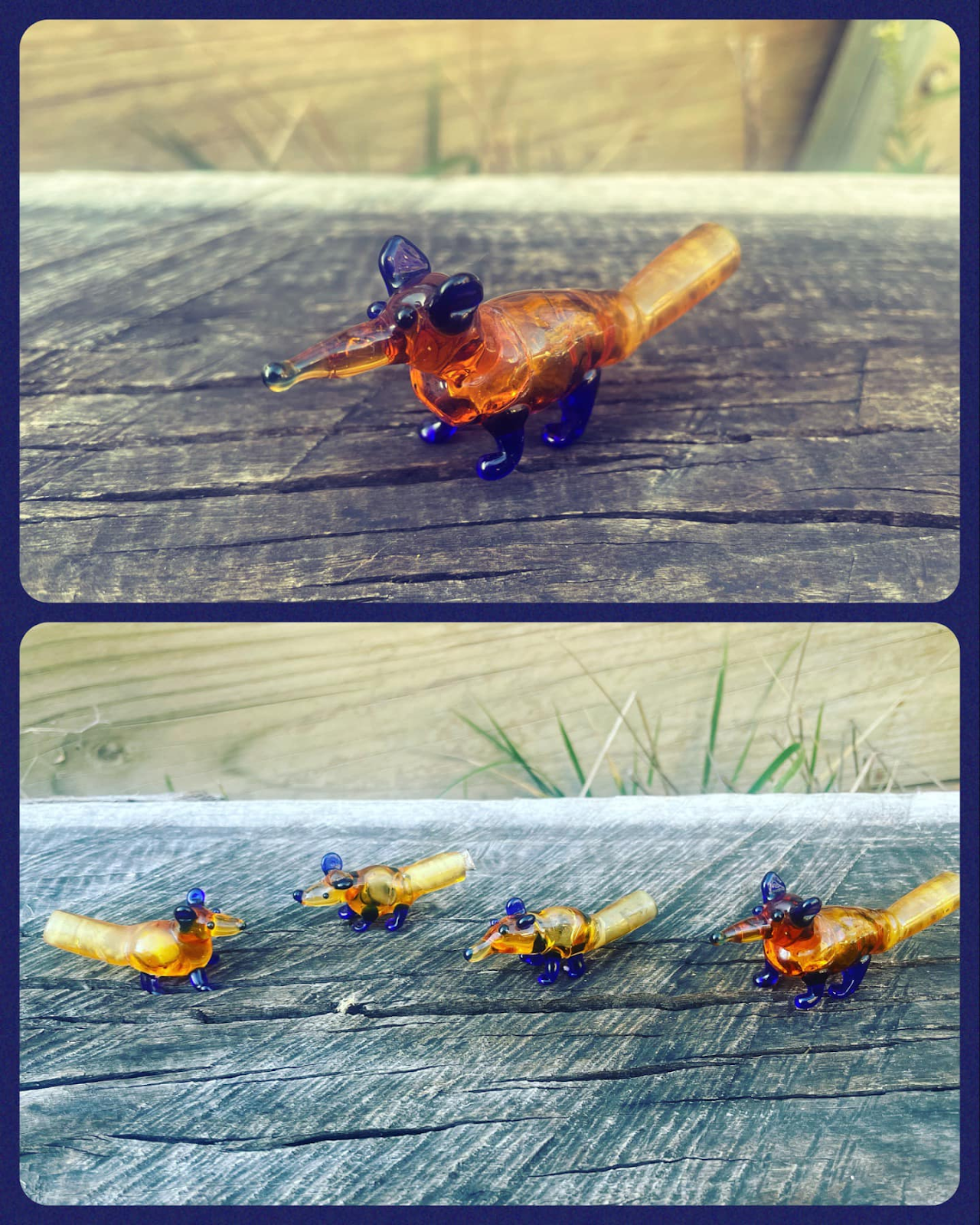What? 23 monochrome, biconical glass beads from the Merovingian period
Where? Sigmaringen
When? 7th
Century
Why? I chose this strand of
beads as I loved how colourful and unique, they are. They are all undecorated,
and whilst they may look simple, the biconical shape is complex to achieve
well, and I have struggled with this in the past. Some of these beads are very
worn, and as you can see the colour appears quite dull, unlike the new glass,
which being modern, also has less impurities. This fits the Low Countries
because Sigmaringen was part of Merovingian dynasty which stretch out across
the Benelux countries/ Low Countries.
Details of the Recreation: I chose to recreate the
strand displayed. Initially, I did not have the confirmed size of the
individual bead. I emailed the British Museum who put me in contact with the
curator. She kindly let me know that the beads average 1cm. I worked closely
with a printed image of the work that I had printed to scale. I used a cm
mapped out on my paper to check sizing and mimicked the more specific shapes
such as the dark blue beads being smaller and less biconical. There weren’t
many details of the excavation, so I used organic material to string the beads
together. Organic materials such as linen thread was commonly used throughout
times and cultures. The lay out of the beads is the same as the museum, but
this may be a modern aesthetic.
 |
The original
|
 |
| My version |
Materials and techniques:
·
Glass
·
Technique: lampwork techniques to recreate
a similar shape and size in each bead.
·
String: Corded string
Images of the process:
Working with Glass:
I have been working on
developing my skill at melting glass and shaping it over the last couple of years.
I have learnt a lot, including where in the flame certain glass must be placed
so that it doesn’t ruin the colour or texture. I have learnt how to steadily
place my hands and rotate both glass and mandrel so that an even amount of
glass, at the right temperature, is kept at the right heat to reproduce the
desired bead.
The necklace presented a
variety of challenges. Glass is a dangerous, sometimes fickle substance, and
certain colours only work properly at a certain heat.
Some of the trickier
techniques (and melting glass onto a mandrel and keeping it even is tricky to
start with!) that I used for this project include:
·
Studying each (photo of) bead in a variety of lights to get
an accurate grasp of the details.
·
Technique of shaping initial bead, then shaping one side,
keeping sides even, and then shaping the other side, whilst keeping everything
even and melting at the correct temperature.
·
Working with tricky colours. These were all tricky. Light
blue flashes (changes colour), red flashes, white burns, green can go red or
brown, yellow gets red markings and the dark blue was a special shade and prone
to melting too hot and reforming with impurities.
·
Shaping similar size beads
Details of the equipment and resources:
·
I used a graphite paddle, mandrels, bead release, a knife, fire
annealing and gravity. I try to use the least tools possible and authentic
equipment that would have been used by the glassmakers of the time. Apart from
my fire set-up, all the equipment I have used would have been used at the time
as well.
·
Clear broken glass was often used as well as imported blocks of coloured
glass. (Regia Anglorum)
·
The glass rods I used to recreate these beads were Effetre Murano – 104
COE soft glass rods. This is a close replica of the glass that would have been
used at the time.
·
Bead artisans would have created a small kiln or furnace. The broken
recycled glass would be put into the furnace through holes in the side to melt
in a dish inside the furnace. Air was pumped into the furnace to keep the
charcoal hot. (Guido)
·
I use a hot head torch and MAPP gas. In the future I have plans to
recreate a small portable kiln but melting glass in a small kiln is very
difficult as getting the heat hot enough to melt the glass is a struggle.
·
Metal rods (mandrels) were dipped with a clay mixture called bead
release. The molten glass is wound onto the rod until the desired shape was
achieved. Once the bead size and shape were achieved, a design could be added
by heating thin bits of glass and wrapping them around the bead, with a
“stringer” that was heated and laid on top. (Guido)
·
I use mandrels that would have been very similar to those used, however,
mine are shorter as they don’t need to be as long to reach into a hot fire. The
bead release I use has the crucial ingredients of water, kaolin and alumina
hydrate, which is a composition that would have been used.
·
Beads would then be moved to an annealing dish in the furnace. This
would prevent thermal shock, lowering the chances of the bead cracking.
·
Instead of annealing them in a furnace, I use a product called
vermiculite to allow the beads to cool down slowly. I also use a kiln. In the
future, I would like to try annealing them in a furnace to see what it is like.
·
After the beads are finished, I remove them from the mandrels, clean
them out with some bead cleaning tools and give them a quick clean with some
soapy water.
Future Projects:
·
In the future, I would like to continue to practice more difficult
skills, e.g., fine line work, millefiori use and making the Chinese Warring
state Beads which had over 100 steps each.
·
I am enjoying creating pieces from different times and cultures that
people have never seen, and I will continue to develop my skills by continuing
to choose challenging and unique projects.
·
I also enjoyed working with the museum and the professor when I
recreated a 133 bead Phoenician necklace, and I would like to continue working
with people like this. Not only was it very educational and rewarding, but it
resulted in me contributing to the historical accuracy of the museum- which I
thought was cool! This project led the British museum to writing more specific
information too, which is awesome!
·
I also intend to work on another historical recreation of a glass making
set up.
Primary resource:
https://www.britishmuseum.org/collection/object/H_1908-0801-538
Provenance:
Sigmaringen, Baden-Württemberg, Germany; grave
5, found 1900; associated with 1908,0801.539
Secondary Resources:
Guido, Margaret. The Glass Beads of Anglo-Saxon
England: c. AD 400-700, Boydell Press, 1999.
Holgate, Barbara. “The Pagan Lady of
Peel”, St. Patrick’s Isle Archaeological Trust, 1987.
Regia Anglorum: https://regia.org/
McGloin, Jemma: Of Beads and
Burials: A Microwear and Experimental Study of Early Medieval Glass and Amber
Beads from the Merovingian Site of Lent-Lentseveld.








